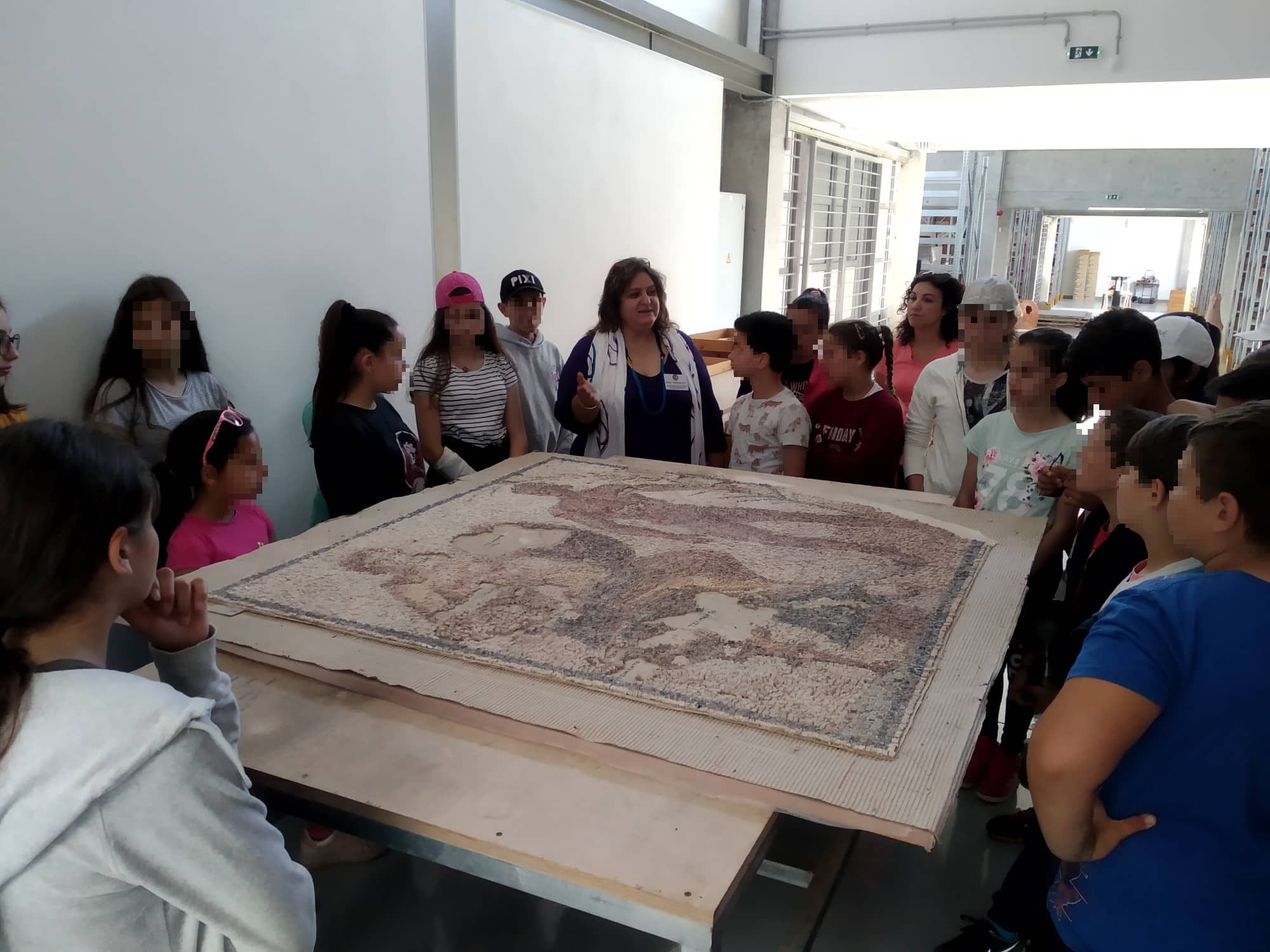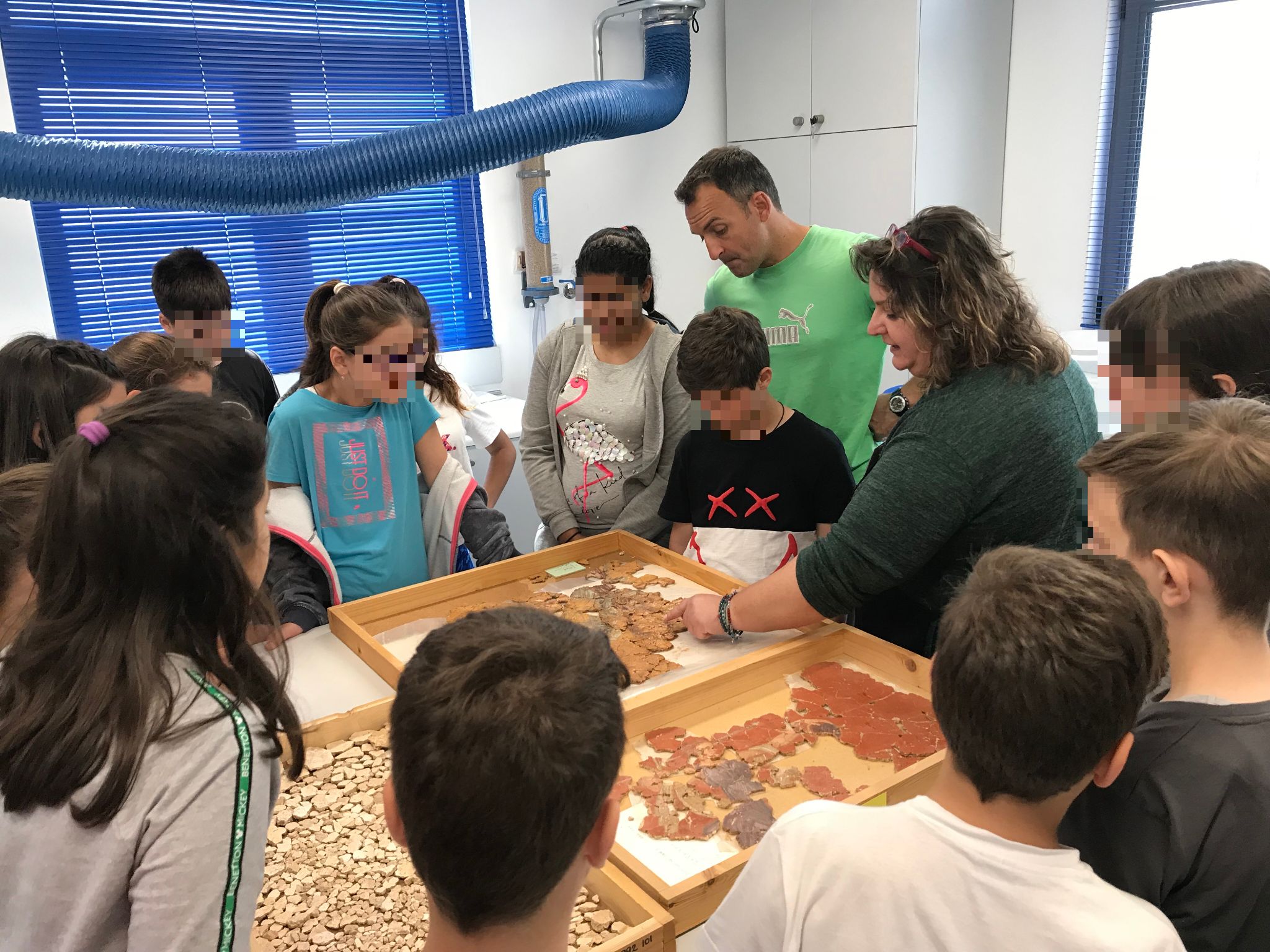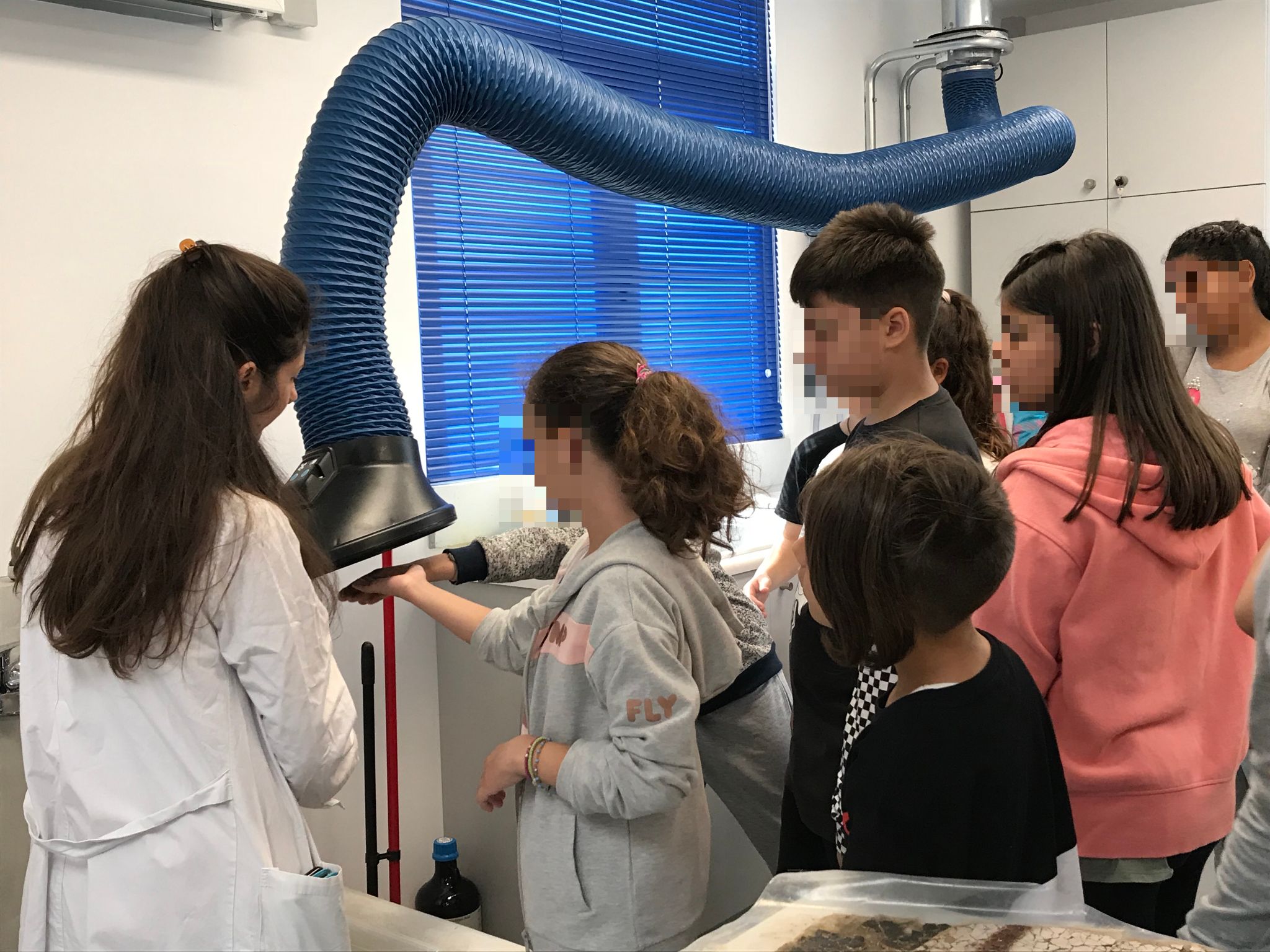
A group of ninth grade students visits Corinth Excavations as archaeologists and workmen conduct fieldwork.
“Open Day” at ASCSA Corinth Excavations: A New Chapter of On-site Programming
For the first time in its 123 year history, Corinth Excavations shared the excavation process from the field to the lab by welcoming children and adults onto its active excavation site and inside its newly constructed storage facility and conservation lab. With the generous permission of the Ephor of Antiquities of the Corinthia, Panayiota Kassimi, Steinmetz Family Foundation Museum Fellow Eleni Gizas implemented a new educational program, titled “Open Day”, that allowed nearly 200 children and adults to observe stages of the archaeological process both on and off the field. Participants came from the Elementary School of Ancient Corinth (Grades 4, 5, and 6), Homo educandus αγωγή in Corinth (Grade 9), Εκπαιδευτήρια Σύγχρονη Παιδεία in Athens (Grade 9), and the Municipal Library of Corinth (two adult groups and one group of mixed age students).
The initial impetus for the program was to bring the school children of Ancient Corinth into the heart of the excavation in order for them to see firsthand the work that is being conducted in their neighborhood and, for many students, by their own family members. It offered an ideal opportunity to bring them inside the newly constructed apothiki, an imposing building constructed through a generous private donation and located a short distance from the site but not open to the public. The eagerness of the Elementary School of Ancient Corinth to participate in the Open Day program prompted the invitation to be extended to two additional schools and to the Municipal Library. The Municipal Library’s initial call for participants, later reposted online by the news sites Loutraki365, on-time news, MyPress, and Sfedona, received such an overwhelmingly positive response, that three Open Days were scheduled with them instead of only one.
Every visiting group was greeted by Gizas at the summit to the ancient Theater and was provided with a broad overview of the work of the American School and a brief background to the excavations in Ancient Corinth. Attendees learned that Corinth Excavations, active for over a century, welcomes an international community of students and scholars, not just from the United States. An unwavering point of fascination was in learning that the hill to the north of the Temple of Apollo and on top of which the village playground is situated, is in fact built of excavation dump from the early excavations of the 20th century.
Steinmetz Fellow Eleni Gizas uses maps to show a group of visitors where the current excavation site is located.
Groups were led to the area northeast of the theater, where Director of Corinth Excavations Chris Pfaff has been conducting fieldwork since 2018. Attendees observed and asked questions to skilled local workmen meticulously excavating archaeological deposits and working closely with the students archaeologists recording finds on iDig, taking photographs, and using the total station to record exact findspots. With the excavation in full view, Gizas explained to the groups the logistics of an archaeological excavation, from how archaeologists decide where to dig to what happens to the finds at the end of the excavation season. Old excavation notebooks were distributed in order to demonstrate how the hand-written notes and hand-drawn plans contrast with the new iDig application that the excavators now use on their iPads. The workmen were eager to show students the interesting finds of the morning, from ceramic fragments to pieces of glass, tesserae, or animal bones. Participants were surprised to learn that archaeologists do not work under a tent during the hot summer months and that it is quite uncommon to come across an intact vessel.

Students from the Elementary School of Ancient Corinth observe archaeologists and workmen excavating as Eleni Gizas provides information on the process of archaeological fieldwork.
Following the excavation site, groups were led to the new apothiki, which became operational in the fall of 2017. Gizas briefed attendees about the post-excavation process of cleaning and conserving the finds, labeling, and storing them, and about the ongoing process of their study in Ancient Corinth through book publications and public online access of photos and descriptions through the database ASCSA.net. Director Emeritus Guy Sanders explained about his own work in Byzantine pottery using the actual objects.
Eleni Gizas and Director Emeritus Guy Sanders speak before a group of school children inside the workroom of the new apothiki.
Head Conservator, Nicol Anastassatou, and her intern, Penny Pitsikou, discussed various projects of conservation, among them the Eutychia mosaic from the South Stoa, a monumental building in the central archaeological site. Groups were shown a short video that documents the temporary removal of the mosaic from the room it adorned originally for the purposes of conservation. Anastassatou provided an in depth look at its archaeological context, construction, and conservation. People were amazed at the complexity of the conservation process and learned that through the generous donations from the Stockman Family Foundation and Kaplan Foundation, funds have been secured for the conservation and the construction of a new shelter that will eventually be constructed over the mosaic at its original findspot for everyone to enjoy. Groups had the opportunity to examine frescoes that were excavated in the area east of the Theater and in Panayia. As captivating as the frescoes were, every single group expressed considerable curiosity in the fume extraction vent that extended across one side of the room. The younger children were especially eager to place their hands under the suction vent.
A group of students watches a short video that documents the temporary removal of the Eutychia mosaic from the room it adorned originally for the purposes of conservation.

Head Conservator Nicol Anastassatou provides an in depth look at the archaeological context, construction, and conservation of the Eutychia mosaic to a group of school children.
An adult group examines fresco fragments inside the conservation lab of the new apothiki.

A school group examines fresco fragments inside the conservation lab of the new apothiki.

Conservation intern, Penny Pitsikou, allows children to feel the suction of the fume extraction vent located inside the conservation lab.
Although it was initiated only a few weeks before the start of the excavation season, the Open Day program promises to become an integral part of Corinth Excavations. In a letter thanking Corinth Excavations and the Ephor of Antiquities of the Corinthia for the opportunity to participate, Rania Sazakli, Manager of Public Programs at the Municipal Library, stated: “Η ευκαιρία που μας δώσατε να σας επισκεφτούμε στο χώρο ανασκαφής και στο νέο χώρο συντήρησης και αποθήκευσης των ευρημάτων, η φιλοξενία, οι γνώσεις και ο επαγγελματισμός σας, έκαναν την ημέρα μας ξεχωριστή. Πιστεύουμε ότι οι πολιτισμικές εμπειρίες κάθε είδους ανοίγουν πόρτες για το μέλλον των παιδιών και εξάπτουν το ενδιαφέρον των ενηλίκων.” (The opportunity that you gave us to visit the excavation site and the new conservation space and storeroom, your hospitality, your knowledge and professionalism, made our day exceptional. We believe that cultural experiences of every kind open doors for the future of children and ignite the interest of adults.)
After the end of the 2019 excavation season, an analogous Open Day program will be held for the residents of Ancient Corinth in July with ASCSA Corinth Excavations staff and the Ephor of Antiquities of the Corinthia, Panayiota Kassimi, welcoming interested visitors at the excavation site and inside the new apothiki.